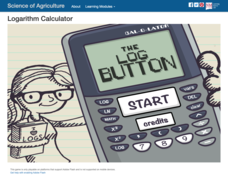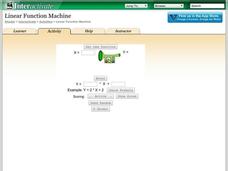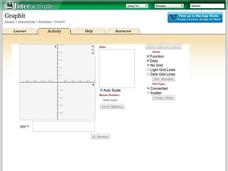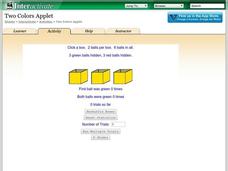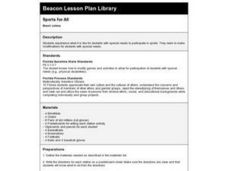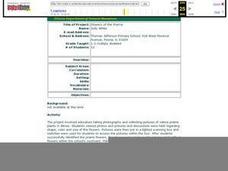Curated OER
Helen Keller
Students describe several obstacles overcome by Helen Keller and identify adversity in their own lives and think about their views of dealing with it and ways of overcoming it.
Curated OER
Connecting Letters and Memory
Elementary students with mild to moderate mental disabilities use a variety of tools to connect letter sounds to images. They use flash cards, posters, and writing while saying to connect letter image to phonemic equivalent. Then, they...
Curated OER
Phonics Help: The Phonic Alphabetic Code Chart
Phonics is a fundamental key to reading success. To help your learners with dyslexia or learning disabilities, try using the phonic alphabetic code chart. The chart and full instructions on how it can be used in the classroom are...
Curated OER
Go Bug!
Second graders explore the lives of insects by participating in a card game. In this metamorphosis lesson, 2nd graders define several scientific vocabulary terms associated with insects and identify the different life cycles associated...
California Academy of Science
Make your own Antelope Horns!
What are those horns for anyway? Little ones discuss the shape, texture, and purpose of horns found on animals such as the deer and antelope. They then pair up and make their own set of antelope horns to wear while visiting a local...
TED-Ed
The Fundamentals of Space-Time: Part 3
If you weren't already blown away by first two installments, check out this clip on how gravity and space-time interact! Our physicist friends, Pontzen and Whyntie, continue their discussion of these motion concepts for your high...
Curated OER
Youth Helping to Elevate Awareness
Eighth graders read a book whose main character has a physical disability, and complete various related activities. They listen to a guest speaker, simulate experiences at school as a disabled individual through the use of wheelchairs,...
Museum of Disability
Taking Down Syndrome to School
Teach your class about the ways they can befriend and understand people who are different from them with a reading comprehension lesson. As youngsters read Taking Down Syndrome to School by Jenna Glatzer, they answer a...
Learning Games Lab
Logarithm Calculator
Support your young scientists' knowledge of logarithms with a quick video lesson. The instruction first presents the relationship between a base-10 logarithm and an exponential equation. It then demonstrates how to use a calculator to...
Shodor Education Foundation
Racing Game with One Die
Pupils roll a die to figure out which car advances on a race track. They determine the rules for each car moving forward and, given the statistics of the winner, compare if it matches their predictions.
Curated OER
Ready-Set-Tech: When a Volcano Erupts
Wouldn't it be a blast to uncover the science behind volcanic eruptions? Explore, research, and examine the nature of volcanoes with three fun hands-on projects kids will love. First the class takes to the Internet to research volcanoes....
TED-Ed
What is the World Wide Web?
Did you know that the World Wide Web and the Internet are not the same thing? Did you know that Tim Berners-Lee is considered the father of the Web? Networks, web servers, web hosts, website addresses, domain names, web languages,...
Vanderbilt University
Healthy Bodies for Boys
Create an inclusive space for scholars to gain milestone information about their growing bodies with a unit designed to meet the needs of learners with disabilities. Topics include the onset of puberty, hormones, hygiene, and more!...
Shodor Education Foundation
Linear Function Machine
What goes in must come out! Learners play with a function machine to determine the correct function. They enter input values and watch as the machine produces the output.
Shodor Education Foundation
Graphit
No graphing calculator? No worries, there's an app for that! Young mathematicians use an app to graph functions. In addition, they can also plot data points.
Shodor Education Foundation
Two Colors Applet
Find the box with two green balls. The applet uses six balls, three green and three red, and hides them in three boxes. Pupils choose a box and click on it to reveal the color of balls inside. Using the chosen box, the simulation keeps...
Shodor Education Foundation
Skew Distribution
Slide the class into a skewed view. Learners alter the location of the median relative to the mean of a normal curve to create a skew distribution. They compare the curve to a histogram distribution with the same skewness.
Curated OER
Sports for All
Third graders complete several sports activities with simulated disabilities. They reflect on the inherent difficulties and brainstorm modifications for each activity.
Curated OER
Flowera of the Prairie
Students with severe disabilities view pictures of flowers in a scanning box and identify them. Outside, they locate flowers on the school's property, label and care for them. Students use flower pictures to aid identification.
Curated OER
The Westing Game: Chapters 13-16
In The Westing Game chapter questions worksheet, students complete several short answer questions over chapters thirteen through sixteen to advance their understanding of the text.
Curated OER
The Home Front
In these World War II home front worksheets, students read several passages about the home front during World War I. Students learn about the evacuation plan, rationing methods, the women, and the home guard.
Curated OER
Understanding to Read and Describe It
Second graders, with hearing disability, practice vocabulary building strategies. In this vocabulary strategy lesson plan, a student practices sight words using word cards. The student verbalizes a sentence with the new words while the...
Curated OER
Identifying Our Similarities, Despite Our Differences
Students discuss similarities and differences among the members of their class. They read and discuss several books about children with disabilities and then draw and/or write about someone they can think of who has a disability and...
Curated OER
Plotting Earthquakes: Diversity of Learner Adaptation
Pupils are divided into four groups that study four separate ecosystems in the community. They first do a field examination for the purpose of developing a detailed report of an ecosystem. Students do a detailed analysis of the change...
Other popular searches
- Severely Disabled Game
- Severely Disabled Reading
- For Severely Disabled
- Severely Disabled Preschool
- Severely Disabled Music
- Severely Disabled Art
- Severely Disabled Lesson
- Severely Disabled p.e.
- Severely Disabled Pe








